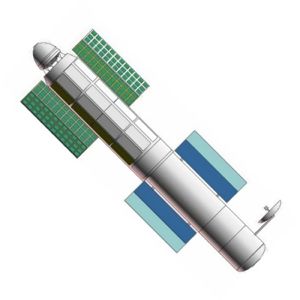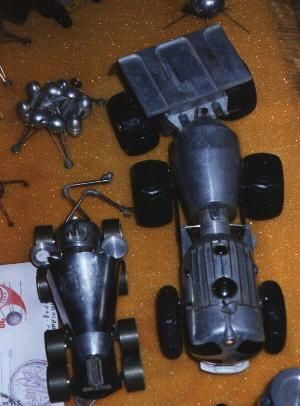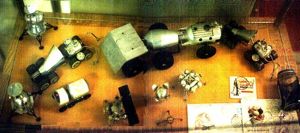
Home - Search - Browse - Alphabetic Index: 0- 1- 2- 3- 4- 5- 6- 7- 8- 9
A- B- C- D- E- F- G- H- I- J- K- L- M- N- O- P- Q- R- S- T- U- V- W- X- Y- Z
TMK-E
 TMK-E Final design of TMK-E spacecraft Credit: © Mark Wade |
Status: Study 1960. Thrust: 74 N (17 lbf). Gross mass: 150,000 kg (330,000 lb). Specific impulse: 10,000 s. Height: 175.00 m (574.00 ft). Span: 20.00 m (65.00 ft).
The spacecraft would be powered by nuclear electric engines, with the reactor moved away from the crew quarters on long telescoping booms. Five landers would deliver a nuclear-powered 'Mars Train' on the surface for a one-year survey of the terrain. The design would be heavily modified as the 1960's progressed, as research showed the Martian atmosphere to be much thinner and the nuclear electric engines to be less efficient than assumed.
Feoktistov's section of OKB-1 felt that the Maksimov TMK-1 design was too limited and optimistic. They concluded that it would not be possible or advisable to produce a single-launch spacecraft. At first they proposed a dual-launch scenario, with the TMK being launched into low earth orbit and going through a long period of systems proving and test. Only after the spacecraft had completed this 'shakedown cruise' would a second N1 launch would put the trans-Mars injection stage into orbit to propel the spacecraft toward Mars.
But Feoktistov was already studying ion engines as a means of either increasing the flight mass of the TMK or reducing the number of launches to get the spacecraft going toward Mars. OKB-1 Section 12, led by M V Melnikov, had already started development of such an engine in 1957 at the urging of S P Korolev. Their 7.5 kgf thrust ion engine design could take the TMK-E on a low acceleration spiraling trajectory away from the Earth until it finally reached escape velocity and headed toward Mars. However to power the engine would require solar panels with a total area of 36,000 square meters - clearly beyond 1959 technology. Feoktistov's solution was to turn to the use of a nuclear reactor to power the ion engine.
Feoktistov's TMK-E became the first project for an expedition to Mars in a spacecraft propelled by nuclear reactor-powered ion engines. The craft would be assembled in near-earth orbit and from there launched toward Mars with a crew of six. The spacecraft as initially designed used a 7 MWt nuclear reactor to power the 7.5 kgf ion engine, which had a predicted specific impulse of 10,000 seconds. The TMK-E would be capable of a three year flight to Mars and return, of which one year was powered flight. From fore to aft the 175 m long spacecraft consisted of:
- A stretched 6 m diameter, 18 m long TMK-1 living section with a shield at the nose, to accommodate a total crew of six
- A small diameter pressurized tunnel to which were docked the two crew-return Mars landing craft and a Soyuz-type earth return capsule
- A long lattice boom, along which was first encountered, at the center of gravity of the spacecraft, the ion engine cluster and propellant tanks
- Four further Mars landing craft, containing the rest of the 'Mars Train' surface vehicles
- A large diameter radiation shield to protect the crewed areas from the reactor
- At the end of the lattice boom, deployed after launch and stabilized by two telescoping struts, the power reactor
- Forward wagon with crew cabin, manipulator arms and a drilling system
- Launch wagon with a platform for a convertiplane (vertical takeoff/horizontal flight) for flying in the Martian atmosphere
- Two wagons with rocket launch platforms. Either rocket (one a spare) could be used for landing the three-man surface crew and returning to dock with the main spacecraft in near-Mars orbit. The landers themselves were four-legged truncated cones, 5.4 m tall and 7 m across the landing gear.
- Aft wagon with a nuclear reactor to power the train
Those who worked on this project included K P Feoktistov, V A Adamovich, V V Mologtsov, K S Shustin, V E Lubinskiy, V I Staroverov, L A Gorshkov, and Ts V Solovyov. Feoktistov was OKB-1's premier manned spacecraft designer and would fly in space on Voskhod 1.
TMK-1 Mission Summary:
- Summary: First Soviet study for a manned Mars flyby; set payload requirement for N1 booster
- Propulsion: LOX/Kerosene
- Braking at Mars: flyby
- Mission Type: Crocco
- Split or All-Up: all up
- ISRU: flyby
- Launch Year: 1971
- Crew: 2
- Outbound time-days: 315
- Mars Stay Time-days: 0
- Return Time-days: 780
- Total Mission Time-days: 1095
- Total Payload Required in Low Earth Orbit-metric tons: 75
- Total Propellant Required-metric tons: 45
- Propellant Fraction: 0.60
- Mass per crew-metric tons: 37
- Launch Vehicle Payload to LEO-metric tons: 75
- Number of Launches Required to Assemble Payload in Low Earth Orbit: 1
- Launch Vehicle: N1
Crew Size: 6. Electric System: 7,000.00 average kW.
Family: Mars Expeditions. Country: Russia. Launch Vehicles: Mars tactical rocket, N1, N1 1969. Propellants: Electric/Xenon. Agency: Korolev bureau. Bibliography: 206, 283, 376, 89.
 | TMK-E Cutaway Cutaway drawing of an early version of the TMK-E spacecraft Credit: Gleb Aleksushin |
 | TMK Mars Lander Separation of Mars lander from an early version of the Soviet TMK-E Manned Mars expedition spacecraft. Credit: Gleb Aleksushin |
 | TMK-1 Early design of TMK-E spacecraft. Credit: © Mark Wade |
 | Nucear electric ship Nuclear electric spacecraft Credit: © Mark Wade |
 | TMK-E RKK Energia drawing of TMK-E Credit: RKK Energia |
 | Marsokhod Nuclear powered crewed Mars Train rover (with ascent stage to orbit in centre). Credit: Andy Salmon |
1957 During the Year - . Launch Vehicle: N1.
- USSR starts ion engine development - .
Nation: Russia.
Related Persons: Feoktistov,
Korolev.
Spacecraft Bus: TMK.
Spacecraft: TMK-E.
At the urging of S P Korolev, OKB-1 Section 12, led by M V Melnikov, started development of an ion engine. By 1959 it would be proposed that clusters of the 7.5 kgf thrust ion engine could take the TMK-E manned Mars spacecraft on a low acceleration spiralling trajectory away from the Earth until it finally reached escape velocity and headed toward Mars. But to power even such a limited engine solar panels with a total area of 36,000 square meters would be required - clearly beyond 1959 technology. Feoktistov's solution was to turn to the use of a nuclear reactor to power the ion engine.
1960 June 23 - . Launch Vehicle: N1.
- Soviet plan for mastery of space issued. - .
Nation: Russia.
Related Persons: Chelomei,
Korolev,
Yangel.
Spacecraft Bus: TMK.
Spacecraft: TMK-E.
Decree 715-296 'On the Production of Various Launch Vehicles, Satellites, Spacecraft for the Military Space Forces in 1960-1967' authorised design of a range of spacecraft and launch vehicles by Korolev, Yangel, and Chelomei. The decree included the N1 (development of launch vehicles of up to 2,000 tonnes liftoff mass and 80 tonne payload, using conventional chemical propellants) and nuclear reactors for space power and propulsion.
1964 July 27 - .
- Space simulator plans - .
Nation: Russia.
Spacecraft: LK,
LK-1,
Soyuz 7K-LOK,
Soyuz A,
TMK-1,
TMK-E.
A two-day conference is held at IAKM to review requirements for trainers and task simulators over the next 6 to 7 years. The plan includes basic instructional versions of planned spacecraft, trainers for flying around the moon, and a mock-up of the TMK Heavy Interplanetary Spacecraft. These will require a new facility of to 7,000 square metres. Trainers and strands at TsPK will be housed in building D, a hangar-type facility. The TBK-60 thermal/barometric chamber will be housed in a single hangar. To fully specify TsPK trainers and stands for the lunar mission, trainers for space navigation, and military combat spacecraft will not be completed until 1965.
1965 June 26 - .
- Poor progress on space trainers - .
Nation: Russia.
Related Persons: Dementiev,
Smirnov,
Titov.
Program: Voskhod,
Lunar L1.
Flight: Soyuz 1,
Soyuz 2A,
Voskhod 3,
Voskhod 4,
Voskhod 5,
Voskhod 6.
Spacecraft: LK-1,
Soyuz A,
Spiral OS,
TMK-1,
TMK-E.
Titov and Kamanin visit LII to review the status of simulator construction. The engineers haven't had any time to even consider trainers for winged spacecraft. The Soyuz trainer will only be completed by July 1966, and the trainer for the new Voskhod configuration is still on paper only. Simulators for manned lunar or planetary flights have not even been discussed yet. It is clear that Kamanin is going to have to go up the chain of command to Dementiev and Smirnov to get resources allocated for the work to be accelerated.
Back to top of page
Home - Search - Browse - Alphabetic Index: 0- 1- 2- 3- 4- 5- 6- 7- 8- 9
A- B- C- D- E- F- G- H- I- J- K- L- M- N- O- P- Q- R- S- T- U- V- W- X- Y- Z
© 1997-2019 Mark Wade - Contact
© / Conditions for Use

